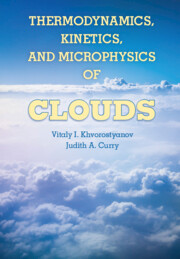Book contents
- Frontmatter
- Contents
- Preface
- 1 Introduction
- 2 Clouds and Their Properties
- 3 Thermodynamic Relations
- 4 Properties of Water and Aqueous Solutions
- 5 Diffusion and Coagulation Growth of Drops and Crystals
- 6 Wet Aerosol Processes
- 7 Activation of Cloud Condensation Nuclei into Cloud Drops
- 8 Homogeneous Nucleation
- 9 Heterogeneous Nucleation of Drops and Ice Crystals
- 10 Parameterizations of Heterogeneous Ice Nucleation
- 11. Deliquescence and Efflorescence in Atmospheric Aerosols
- 12 Terminal Velocities of Drops and Crystals
- 13 Broad Size Spectra in Clouds and the Theory of Stochastic Condensation
- 14 Analytical Solutions to the Stochastic Kinetic Equation for Precipitating Clouds
- References
- Notations
- Index
2 - Clouds and Their Properties
Published online by Cambridge University Press: 05 September 2014
- Frontmatter
- Contents
- Preface
- 1 Introduction
- 2 Clouds and Their Properties
- 3 Thermodynamic Relations
- 4 Properties of Water and Aqueous Solutions
- 5 Diffusion and Coagulation Growth of Drops and Crystals
- 6 Wet Aerosol Processes
- 7 Activation of Cloud Condensation Nuclei into Cloud Drops
- 8 Homogeneous Nucleation
- 9 Heterogeneous Nucleation of Drops and Ice Crystals
- 10 Parameterizations of Heterogeneous Ice Nucleation
- 11. Deliquescence and Efflorescence in Atmospheric Aerosols
- 12 Terminal Velocities of Drops and Crystals
- 13 Broad Size Spectra in Clouds and the Theory of Stochastic Condensation
- 14 Analytical Solutions to the Stochastic Kinetic Equation for Precipitating Clouds
- References
- Notations
- Index
Summary
Cloud Classification
Clouds represent the large visible ensembles of drops or crystals suspended in the gaseous atmosphere. Clouds in the Earth’s atmosphere result from the condensation or deposition of water vapor. Clouds on other planets may result from the condensation of the other gases. For example, clouds on Venus may consist of sulfuric acid drops, some clouds on Mars may consist of CO2 ice crystals, and the clouds on Jupiter may consist of H2O–NH3 drops and CH3 ice crystals (e.g., Curry and Webster, 1999). Hereafter, we consider the Earth’s water clouds, although most of the equations in this book can be applied with appropriate modifications to the clouds of other substances on other planets.
Numerous studies of the condensation process have shown that condensation occurs when the water vapor pressure slightly exceeds the saturated vapor pressure, or is supersaturated—i.e., the relative humidity slightly exceeds 100%. At the same time, it is known that the relative humidity near the ground is most often 40–80%, decreases upward, and is 2–3times smaller at the level of the tropopause. Therefore, cloud formation requires a mechanism that increases the relative humidity to ≈100%. Cloud formation mechanisms include cooling due to vertical uplift (convection) or radiative cooling, horizontal transport (advection) of heat and moisture, or the mixing of air masses. There is a great variety of conditions and motions in the atmosphere that lead to cloud formation, which results in a diversity of cloud properties and appearances.
- Type
- Chapter
- Information
- Thermodynamics, Kinetics, and Microphysics of Clouds , pp. 9 - 44Publisher: Cambridge University PressPrint publication year: 2014



